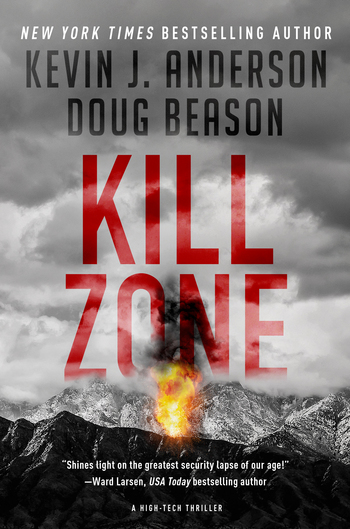 Power duo Kevin J. Anderson and Doug Beason team up in Kill Zone, a perilous disaster thriller for the modern age.
Power duo Kevin J. Anderson and Doug Beason team up in Kill Zone, a perilous disaster thriller for the modern age.
Deep within a mountain in Albuquerque, New Mexico, a Cold War-era nuclear weapons storage facility is being used to covertly receive more than 100,000 tons of nuclear waste stored across the US. Only Department of Energy employee, Adonia, and a few others including a war hero, a senator, and an environmental activist, are allowed access to perform a high-level security review of the facilities. But Hydra Mountain was never meant to securely hold this much hazardous waste, and it has the potential to explode, taking with it all of Albuquerque and spreading radioactivity across the nation.
This disaster situation proves all too possible when a small plane crashes at a nearby military base, setting off Hydra’s lockdown and trapping Adonia and her team in the heart of the hazardous, waste-filled mountain. Now, the only direction for them to go is deeper into the mountain, through the tear gas and into a secretive area no one was ever supposed to know about.
Chapter 1
Westchester County Airport, New York
Though the airport wasn’t the nearest one to the target, it was close to New York City. And more importantly, it had a privately owned Daher TBM 930 aircraft available, no questions asked.
He’d paid two thousand dollars cash to rent the fast plane dry—unfueled—which allowed him to load the minimum amount of gas. That way he could take off with three-quarters of a ton of payload. He wouldn’t have to fly far, only thirty miles, and he’d chosen the single-engine Daher for its speed, up to 380 miles an hour.
By his calculations, he should be able to achieve more than 500 mph when he came straight in at a dive. At that speed, carrying 7,400 pounds max weight, he’d easily punch through the containment building’s roof.
And that was before his payload of ANFO exploded.
The entire Sanergy activist group would be proud that he’d made such a clear, indisputable statement. They would wish they had listened to his urgings, because now the nuclear power industry would grind to a halt thanks to his bold statement this morning. His only regret was that he wouldn’t live to see it and bask in the praise of like-minded people. But he saw no more effective way to stop the madness, put a halt to the never-ending, poisonous buildup that continued to grow out of control.
Though dawn’s glow lit the eastern horizon, the sun hadn’t risen yet. The TBM 930 was parked behind the general aviation terminal, and he drove his windowless van up to the large passenger door, where he could transfer the plastic bags of ammonium nitrate fuel oil explosive without being seen. He took his time, careful not to rip the sides of the packaging. He couldn’t afford to be caught, not after all the planning, the endless flight lessons, and even assembling the ANFO.
It had been easy buying fertilizer at a dozen different landscaping stores, rather than making the ammonium nitrate himself, and he’d discovered that #2 simple-distillate home heating oil worked better than diesel for the fuel oil part of the explosive mixture. He’d tested a small batch of his concoction in a remote field, a hundred miles from where he lived, and the one-pound explosion worked like a charm.
Working swiftly and efficiently, trying not to think beyond the task at hand, he finished loading the Daher without raising suspicions. After driving the van to a nearby parking area, he jogged back to the plane in the dawn silence and started the preflight checklist. He only bothered with the takeoff part of the flight. No need to worry about the return or the landing.
He dispensed with everything except the correct protocols to take off and fly thirty miles, gaining altitude all the way so his dive would attain the max velocity possible before impact.
As the new day brightened, he saw hints of an early morning storm coming in, a nor’easter with strong winds. A silver lining, he thought. The storm would help disperse the radioactive cloud over New York City in the aftermath of the crash.
The time for endless talking was over. Time to kick the tires and light the fires. He had a date with destiny.
2
Granite Bay Nuclear Power Plant, New York
Adonia Rojas surveyed her domain of Granite Bay, frowning—not from what she saw, but from what she couldn’t see.
As the site manager, she held absolute power over all operations and people at the nuclear power plant. When she spoke, people scrambled to do her bidding, although she didn’t abuse her power. Adonia was tall and attractive, young for her position of authority. She was the only female site manager of a nuclear power plant in the U.S., and at thirty-five she was also the Nuclear Regulatory Commission’s youngest executive. She’d only had this job for six months, but any doubters needed less than five minutes of conversation to be convinced that Adonia’s rapid rise in her career was due to her brains rather than her looks.
Like all site managers, she hadn’t had a grace period to deal with the backlog and bureaucratic crises, a chance to get her feet under her so she could face the larger challenges. Some of her colleagues had been hit with disasters on their first day on the job. At a bustling, high-tech nuclear power plant, site managers couldn’t afford to have a learning curve.
Colonel Shawn Whalen, her former boyfriend, had once told her that her authority at Granite Bay was equivalent to that of a commander in a war zone.
Instead of being confident, though, this morning Adonia had arrived at the plant after two sleepless nights in a row, not sure how she would deal with the buildup of spent fuel rods. The storage problem was completely out of her control, and it wasn’t going away.
Overlooking the placid shores of the Hudson River sixty miles north of New York City, the morning view looked serene. Columns of white steam roiled out of two massive natural-draft cooling towers, each four hundred feet high.
Directly below, next to the wet-storage facility one building away, Adonia could see sparks flying at a worksite as a welding crew repaired a vacuum tank. In the middle of the one-point-seven-square-mile complex, a fuel tanker truck toiled around temporary storage buildings as it approached the admin center.
Adonia’s headquarters building, a glass-faced administrative tower, was strategically located at the southwest corner of the site. From the tenth floor, she had an unobstructed view of the fenced Granite Bay facility. And except for the constant buildup of spent rods, all was running smoothly.
No aircraft, not even small drones, were allowed to fly within five miles of Granite Bay’s restricted airspace. Only satellite infrared sensors could detect which building on the large site housed the two-unit pressurized water reactor, filled with over 7,500 highly radioactive uranium rods. A quarter of the rods were retired to cooling pools and exchanged for new ones every year.
Granite Bay provided nearly two gigawatts of electricity to New England. The power plant itself didn’t cause Adonia’s headaches, but all those spent uranium rods still emitted large amounts of radiation after they left the reactor’s core. Though not sufficient to keep powering the reactor, the 13.1-foot-high rods were more than active enough to emit a lethal radiation dose within minutes.
Granite Bay’s spent rods were stored upright in cradles, immersed in forty feet of water, safely covered with constantly circulating liquid that absorbed the radiation and carried away the heat so the pool didn’t come to a boil.
After five years of cooling down, the still-radioactive rods were removed from the deep pools and encased in massive steel and concrete containers, which were filled with inert gas. These containers were then stored inside newer “temporary” buildings.
And just sat there. The dry, high-level nuclear material kept accumulating in storage.
That was where the process ground to a halt. Granite Bay—as with every other nuclear power plant in the nation—had no place to store the deadly material. The containers of high-level waste were ready to be shipped to permanent storage, far from Granite Bay, where they would be safe from any mishaps. But with decades of politics and inaction, there was no facility to receive them. Anywhere.
That was what kept Adonia up at night. It was a disaster waiting to happen. Granite Bay was a power-generating plant, not a permanent storage facility, but all those cooled rods just sat here temporarily—in other words, “forever”—in a place not designed for long-term storage. And she couldn’t do a damn thing about it.
Adonia’s only consolation was that at least she wasn’t alone. Her fellow site managers in thirty states were in the same boat. Granite Bay, like every one of the sixty-one commercially operating nuclear power plants in the U.S., was simply running out of room.
As the early-morning storm blew in, wind whipped dust and leaves around the site and swift clouds closed in to smother the brightening dawn. When the outside temperature plummeted twenty-one degrees in ten minutes, moisture condensed on her office window.
Adonia watched the back of the fuel tanker truck come around the corner near where the workers were welding the vacuum tank, rushing to finish before the storm. Flashers on, the fuel truck backed up slowly toward the bright welder’s arc. A shower of sparks swirled in a macabre dance, swept up by the errant breezes, fed by the welder’s arc, rising high.
Adonia looked up into the darkening clouds high above the site, saw one spark much brighter and higher than the others. For a moment she didn’t realize this wasn’t just a spark from the welder. It moved in a straight line, heading down, growing larger. Like an incoming missile.
Copyright © 2019
Order Your Copy











